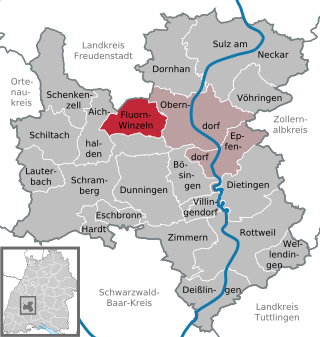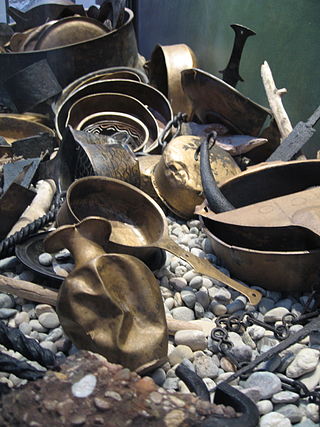The Council of Cannstatt, also referred to as the blood court at Cannstatt, was a council meeting at Cannstatt, now a part of Stuttgart, in 746 that took place as a result of an invitation by the Mayor of the Palace of Austrasia, Carloman, the eldest son of Charles Martel, of all nobles of the Alemanni.

Fluorn-Winzeln is a municipality in the district of Rottweil, in Baden-Württemberg, Germany.
Macrian or Makrian was the king of the Bucinobantes, an Alemannic tribe, in the late fourth century and the brother of Hariobaudes. Macrian tried to confederate all the north Germanic and Alemannic tribes together against Rome.
Uncelen, Uncelin, or Uncilin was the Duke of Alemannia from 587 to 607. He was appointed to replace Leutfred by the Austrasian king Childebert II.

The Upper Germanic-Rhaetian Limes, or ORL, is a 550-kilometre-long section of the former external frontier of the Roman Empire between the rivers Rhine and Danube. It runs from Rheinbrohl to Eining on the Danube. The Upper Germanic-Rhaetian Limes is an archaeological site and, since 2005, a UNESCO World Heritage Site. Together with the Lower Germanic Limes it forms part of the Limes Germanicus.

A burgus or turris ("tower") is a small, tower-like fort of the Late Antiquity, which was sometimes protected by an outwork and surrounding ditches. Darvill defines it as "a small fortified position or watch-tower usually controlling a main routeway."

The Roman fort at Weissenburg, called Biriciana in ancient times, is a former Roman ala castellum, which is a UNESCO World Heritage Site located near the Upper Germanic-Rhaetian Limes. It lies in the borough of Weißenburg in the Middle Franconian county of Weißenburg-Gunzenhausen in Germany. Today the castellum is one of the most important sites of research in the Roman limes in Germany. The site contains partly subterranean building remains, a reconstructed north gateway, large thermal baths and a Roman Museum with an integrated Limes Information Centre.

The Lower Germanic Limes is the former frontier between the Roman province of Germania Inferior and Germania Magna. The Lower Germanic Limes separated that part of the Rhineland left of the Rhine as well as the southern part of the Netherlands, which was part of the Roman Empire, from the less tightly controlled regions east of the Rhine.

The Neckar-Odenwald Limes is a collective term for two, very different early sections of the Upper Germanic-Rhaetian Limes, a Roman defensive frontier line that may have been utilised during slightly different periods in history. The Neckar-Odenwald Limes consists of the northern Odenwald Limes (Odenwaldlimes), a cross-country limes with camps, watchtowers and palisades, which linked the River Main with the Neckar, and the adjoining southern Neckar Limes (Neckarlimes), which in earlier research was seen as a typical 'riverine limes', whereby the river replaced the function of the palisade as an approach obstacle. More recent research has thrown a different light on this way of viewing things that means may have to be relativized in future. The resulting research is ongoing.
The Alb Limes is a Roman frontier fortification or limes of the late 1st century AD in the Swabian Jura, also known as the Swabian Alb. The Alb Limes runs for just under 135 kilometres from Rottweil in the southwest to Heidenheim an der Brenz in the northeast.
The Main Limes, also called the Nasser Limes, was built around 90 AD and, as part of the Upper Germanic-Rhaetian Limes, formed the frontier of the Roman Empire in the area between the present day villages of Großkrotzenburg and Bürgstadt. In this section the limes adjoined the River Main (Moenus), which forms a natural boundary for about 50 kilometres here, so "Main" refers to the river.

The Limesfall is the name given to the abandonment of the Upper Germanic-Rhaetian Limes in the mid-3rd century AD by the Romans and the withdrawal of imperial troops from the provinces on the far side of the rivers Rhine and Danube to the line of those rivers. It is sometimes called the fall of the limes.
Hariobaudes was an Alemannic petty king in the 4th century AD. The Roman writer Ammianus Marcellinus reports that Julian crossed the Rhine at Mainz in 359 and concluded a peace treaty with the Alemannic kings Hariobaud, Macrian, Urius, Ursicinus, Vadomarius and Vestralpus after they agreed to return all prisoners.
Urius was an Alemannic petty king in the 4th century AD. The Roman writer Ammianus Marcellinus reports that Julian crossed the Rhine at Mainz in 359 and concluded a peace treaty with the Alemannic kings Urius, Hariobaudes, Macrian, Vadomarius, Ursicinus and Vestralpus.
Hortarius was an Alemannic king in the 4th century.
Agenaric, also called Serapio, was an Alemannic prince in the 4th century. Agenaric was the son of petty king Mederic and the nephew of another petty king, Chnodomarius. In 357, together with his uncle, Agenaric commanded the Alemannic army at the Battle of Strasbourg, in which the Alemanni were defeated by Julian.
Gundomad or Gundomar, was an Alemannic petty king in the area around Breisgau, Germany in the 4th century. The Roman historian Ammianus Marcellinus reports that Gundomad, together with his brother Vadomarius, in 354 concluded a peace treaty at Augst after having been defeated in battle by emperor Constantius II. In 357, Gundomad was killed by his own people for having been to loyal to the Romans. They then made an uprising against emperor Julian.
Suomarius was an Alemannic petty king in the 4th century.

Vadomarius was an Alemannic king and Roman general, who shared power with his brother Gundomadus. After instigating an indecisive campaign in Gaul against the Romans, Vadomarius and his brother signed a treaty with the Roman emperor Constantius II in AD 356. Encouraged by Constantius II, Vadomarius employed his Alemanni forces in an attack against Julian. Vadomarius then concluded a treaty with Julian, after which, he unsuccessfully attempted to play the two Roman figures against one another. When Julian was made aware of this, he arrested Vadomarius and banished him to Hispania. His son Vithicabius succeeded him as king. Later, Vadomarius allied himself with Rome under emperors Jovian and Valens, leading his forces against the usurper Procopius and fighting the Persians on Rome's behalf.
Vithicabius was an Alemannic petty king from 360 to 368. He was a son of Vadomarius, and succeeded his father as king after the latter had been banished to Hispania by emperor Julian. He had grown up in Roman custody. Ammianus Marcellinus describes Vithicabius as a physically weak, but a brave and aggressive leader. Although having promised Julian to maintain peace, Vithicabius continued raiding Roman territory. He was assassinated in 368 under Valentinian I by a bribed servant, but the Alemannic raids on Roman territory continued nevertheless.







